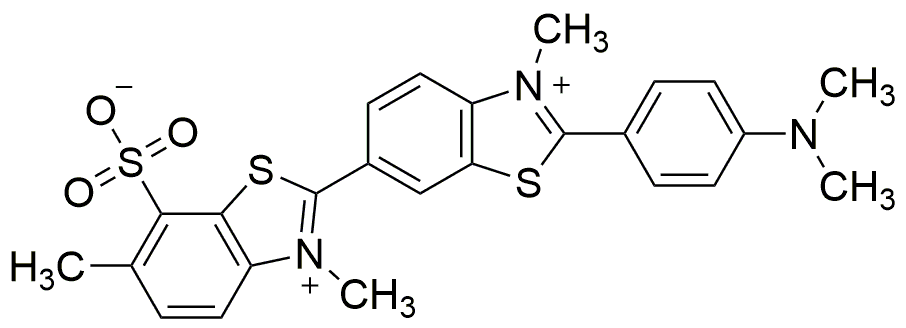Thioflavine S is widely utilized in research focused on:
- Biological Staining: Commonly used as a fluorescent dye to stain amyloid fibrils in biological samples, aiding in the study of neurodegenerative diseases like Alzheimer's.
- Cell Imaging: Employed in microscopy techniques to visualize cellular structures, providing researchers with insights into cell morphology and function.
- Drug Discovery: Used in high-throughput screening assays to identify compounds that can inhibit amyloid formation, which is crucial for developing potential therapeutic agents.
- Environmental Monitoring: Applied in studies to detect and quantify pollutants in water sources, helping industries comply with environmental regulations.
- Material Science: Utilized in the development of new materials, particularly in creating sensors that respond to specific biological or chemical stimuli.
General Information
Properties
Safety and Regulations
Applications
Thioflavine S is widely utilized in research focused on:
- Biological Staining: Commonly used as a fluorescent dye to stain amyloid fibrils in biological samples, aiding in the study of neurodegenerative diseases like Alzheimer's.
- Cell Imaging: Employed in microscopy techniques to visualize cellular structures, providing researchers with insights into cell morphology and function.
- Drug Discovery: Used in high-throughput screening assays to identify compounds that can inhibit amyloid formation, which is crucial for developing potential therapeutic agents.
- Environmental Monitoring: Applied in studies to detect and quantify pollutants in water sources, helping industries comply with environmental regulations.
- Material Science: Utilized in the development of new materials, particularly in creating sensors that respond to specific biological or chemical stimuli.
Documents
Safety Data Sheets (SDS)
The SDS provides comprehensive safety information on handling, storage, and disposal of the product.
Product Specification (PS)
The PS provides a comprehensive breakdown of the product’s properties, including chemical composition, physical state, purity, and storage requirements. It also details acceptable quality ranges and the product's intended applications.
Certificates of Analysis (COA)
Search for Certificates of Analysis (COA) by entering the products Lot Number. Lot and Batch Numbers can be found on a product’s label following the words ‘Lot’ or ‘Batch’.
*Catalog Number
*Lot Number
Certificates Of Origin (COO)
This COO confirms the country where the product was manufactured, and also details the materials and components used in it and whether it is derived from natural, synthetic, or other specific sources. This certificate may be required for customs, trade, and regulatory compliance.
*Catalog Number
*Lot Number
Safety Data Sheets (SDS)
The SDS provides comprehensive safety information on handling, storage, and disposal of the product.
DownloadProduct Specification (PS)
The PS provides a comprehensive breakdown of the product’s properties, including chemical composition, physical state, purity, and storage requirements. It also details acceptable quality ranges and the product's intended applications.
DownloadCertificates of Analysis (COA)
Search for Certificates of Analysis (COA) by entering the products Lot Number. Lot and Batch Numbers can be found on a product’s label following the words ‘Lot’ or ‘Batch’.
*Catalog Number
*Lot Number
Certificates Of Origin (COO)
This COO confirms the country where the product was manufactured, and also details the materials and components used in it and whether it is derived from natural, synthetic, or other specific sources. This certificate may be required for customs, trade, and regulatory compliance.

